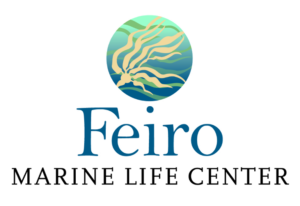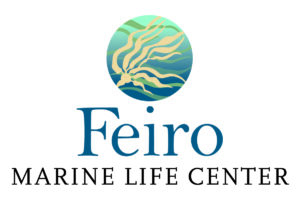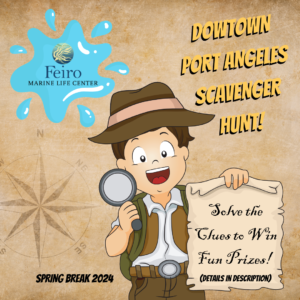SEASONAL HOURS:
12pm - 4pm
Thursdays - Mondays
Closed Tuesdays & Wednesdays
Summer Hours Begin Thurs, May 23
Masks On! Hour
First Saturday of the Month
9am-10am

SEASONAL HOURS:
12pm - 4pm
Thursdays - Mondays
Closed Tuesdays & Wednesdays
Summer Hours Begin Thurs, May 23
Masks On! Hour
First Saturday of the Month
9am-10am
Citizen Science
Feiro Marine Life Center coordinates data collection for a number of citizen science projects of local, regional and national significance. These are the active projects. Join us!
Junvenile Sea Stars in Freshwater Bay
Partners: Olympic National Park, Olympic Coast National Marine Sanctuary, Multi Agency Rocky Intertidal Network
Summary of Surveys
 We began monitoring the populations of sea stars at Bachelor Point, Freshwater Bay, in November 2013 after we heard about the impact the sea star wasting disease had on populations in Puget Sound and along the Pacific coast from California to Alaska. We found seven species of sea stars with Ochre and Blood stars being the most abundant. The sea stars were spared until May 2014 when the disease hit the area. Within three months the Ochre star population was devastated from a high of 120 to three individuals in the survey area. Three surveys conducted in January, April and August 2015 have found only a slight increase in number of Ochre stars ranging between 9 and 12 animals and luckily none of these stars were diseased. The Blood star population got infected, but by fall 2014 these sea stars seemed to have recovered from the disease.
We began monitoring the populations of sea stars at Bachelor Point, Freshwater Bay, in November 2013 after we heard about the impact the sea star wasting disease had on populations in Puget Sound and along the Pacific coast from California to Alaska. We found seven species of sea stars with Ochre and Blood stars being the most abundant. The sea stars were spared until May 2014 when the disease hit the area. Within three months the Ochre star population was devastated from a high of 120 to three individuals in the survey area. Three surveys conducted in January, April and August 2015 have found only a slight increase in number of Ochre stars ranging between 9 and 12 animals and luckily none of these stars were diseased. The Blood star population got infected, but by fall 2014 these sea stars seemed to have recovered from the disease.
Other sea stars observed at Freshwater Bay include Rainbow, Mottled, Sunflower and Morning Sunstar. We never saw more than 13 individuals of any of these species, but since August 2014 we have at the most seen two individuals and the Mottled and Sunflower stars seem to have disappeared from our survey site. The six-armed sea star is also present in Freshwater Bay, but at a slightly different location than all the other stars; under rocks a little further into the bay. This star was also affected by the wasting disease, but a focused search in May 2015 found 30 healthy six-armed stars. 
All the Ochre stars we have observed at Freshwater Bay have always been quite large with an average radius of about 18-20 cm (7-8”). In the surveys after the devastation we have been looking for juveniles since that will be the fastest way for the population to rebound. However, we have yet to see a juvenile Ochre star. Contact Helle Andersen for details.
Summary of Surveys

We began monitoring the populations of sea stars at Bachelor Point, Freshwater Bay, in November 2013 after we heard about the impact the sea star wasting disease had on populations in Puget Sound and along the Pacific coast from California to Alaska. We found seven species of sea stars with Ochre and Blood stars being the most abundant. The sea stars were spared until May 2014 when the disease hit the area. Within three months the Ochre star population was devastated from a high of 120 to three individuals in the survey area. Three surveys conducted in January, April and August 2015 have found only a slight increase in number of Ochre stars ranging between 9 and 12 animals and luckily none of these stars were diseased. The Blood star population got infected, but by fall 2014 these sea stars seemed to have recovered from the disease.
Other sea stars observed at Freshwater Bay include Rainbow, Mottled, Sunflower and Morning Sunstar. We never saw more than 13 individuals of any of these species, but since August 2014 we have at the most seen two individuals and the Mottled and Sunflower stars seem to have disappeared from our survey site. The six-armed sea star is also present in Freshwater Bay, but at a slightly different location than all the other stars; under rocks a little further into the bay. This star was also affected by the wasting disease, but a focused search in May 2015 found 30 healthy six-armed stars.

All the Ochre stars we have observed at Freshwater Bay have always been quite large with an average radius of about 18-20 cm (7-8”). In the surveys after the devastation we have been looking for juveniles since that will be the fastest way for the population to rebound. However, we have yet to see a juvenile Ochre star. Contact Helle Andersen for details.
Peabody Creek Restoration
Partners: City of Port Angeles, North Olympic Salmon Coalition, Clallam County Health & Human Services, Clallam County StreamKeepers, GreenCrow
Summary of Restoration Effort
 For the last couple of years the citizen science group, Friends of Peabody Creek, has worked on improving the water quality and restoring the creek habitats for fish and wildlife. In addition, the group has started to enhance trails along the creek to improve access to the watershed and thereby increase the appreciation of the creek by the local community. Feiro utilizes Peabody Creek watershed extensively in school programs.
For the last couple of years the citizen science group, Friends of Peabody Creek, has worked on improving the water quality and restoring the creek habitats for fish and wildlife. In addition, the group has started to enhance trails along the creek to improve access to the watershed and thereby increase the appreciation of the creek by the local community. Feiro utilizes Peabody Creek watershed extensively in school programs.
Friends of Peabody Creek support the Clallam County StreamKeepers by conducting quarterly water quality and physical habitat surveys of Peabody Creek and yearly surveys of the invertebrate community. The surveys usually take about 4-5 hours and can be conducted with a minimum crew of two. Contact StreamKeepers for further details.
Peabody Creek Restoration
Partners: City of Port Angeles, North Olympic Salmon Coalition, Clallam County Health & Human Services, Clallam County StreamKeepers, GreenCrow
Summary of Restoration Effort

For the last couple of years the citizen science group, Friends of Peabody Creek, has worked on improving the water quality and restoring the creek habitats for fish and wildlife. In addition, the group has started to enhance trails along the creek to improve access to the watershed and thereby increase the appreciation of the creek by the local community. Feiro utilizes Peabody Creek watershed extensively in school programs.
Friends of Peabody Creek support the Clallam County StreamKeepers by conducting quarterly water quality and physical habitat surveys of Peabody Creek and yearly surveys of the invertebrate community. The surveys usually take about 4-5 hours and can be conducted with a minimum crew of two. Contact StreamKeepers for further details.
Mussel Stormwater Monitoring Program
Partners: Washington Department of Fish & Wildlife
Summary of Monitoring Effort
In October 2015 WDFW in partnership with the Stormwater Monitoring Program initiated a stormwater pollution project which will evaluate the health of the nearshore environments at 73 locations throughout Puget Sound. The WDFW biologists are using cages with Penn Cove mussels to track where and how much stormwater pollution is entering the sound. Mussels do not metabolize contaminants so any pollution accumulates in their tissue. To make this large scale effort possible WDFW solicited volunteers to install and retrieve the mussel cages. Feiro volunteers installed cages at two Port Angeles sites and the mussels will stay at the locations until the survey has ended, when Feiro volunteers will retrieve the cages and deliver the mussels to WDFW biologists for chemical analyses. Contact Helle Andersen for details.
effort possible WDFW solicited volunteers to install and retrieve the mussel cages. Feiro volunteers installed cages at two Port Angeles sites and the mussels will stay at the locations until the survey has ended, when Feiro volunteers will retrieve the cages and deliver the mussels to WDFW biologists for chemical analyses. Contact Helle Andersen for details.
Mussel Stormwater Monitoring Program
Partners: Washington Department of Fish & Wildlife
Summary of Monitoring Effort

In October 2015 WDFW in partnership with the Stormwater Monitoring Program initiated a stormwater pollution project which will evaluate the health of the nearshore environments at 73 locations throughout Puget Sound. The WDFW biologists are using cages with Penn Cove mussels to track where and how much stormwater pollution is entering the sound. Mussels do not metabolize contaminants so any pollution accumulates in their tissue. To make this large scale effort possible WDFW solicited volunteers to install and retrieve the mussel cages. Feiro volunteers installed cages at two Port Angeles sites and the mussels will stay at the locations until the survey has ended, when Feiro volunteers will retrieve the cages and deliver the mussels to WDFW biologists for chemical analyses. Contact Helle Andersen for details.
Smolt Monitoring in Tumwater Creek
Partners: Lower Elwha Klallam Tribe
Summary of Monitoring Effort
 In 2015 Feiro started monitoring the smolt populations of Coho, Steelhead and Cutthroats in Tumwater Creek. The monitoring effort was conducted in collaboration with the Lower Klallam Tribe and the Natural Resources at North Olympic Skill Center. The effort is planned to be continued in the spring of 2018. The Lower Elwha Tribe will lead the installation of the smolt trap in late spring and for the next couple of months Feiro volunteers will be monitoring the trap daily for smolts.s.
In 2015 Feiro started monitoring the smolt populations of Coho, Steelhead and Cutthroats in Tumwater Creek. The monitoring effort was conducted in collaboration with the Lower Klallam Tribe and the Natural Resources at North Olympic Skill Center. The effort is planned to be continued in the spring of 2018. The Lower Elwha Tribe will lead the installation of the smolt trap in late spring and for the next couple of months Feiro volunteers will be monitoring the trap daily for smolts.s.
The smolts are identified to species and measured for length and weight before returned to the creek. Depending on number of crew members (can be done by one person), number of smolts and debris each visit may take about 1 hour. The Lower Elwha Tribe will receive the final data and incorporates this into their smolt database which covers several streams in Clallam County. Contact Helle Andersen for details.
Smolt Monitoring in Tumwater Creek
Partners: Lower Elwha Klallam Tribe
Summary of Monitoring Effort

In 2015 Feiro started monitoring the smolt populations of Coho, Steelhead and Cutthroats in Tumwater Creek. The monitoring effort was conducted in collaboration with the Lower Klallam Tribe and the Natural Resources at North Olympic Skill Center. The effort is planned to be continued in the spring of 2018. The Lower Elwha Tribe will lead the installation of the smolt trap in late spring and for the next couple of months Feiro volunteers will be monitoring the trap daily for smolts.s.
The smolts are identified to species and measured for length and weight before returned to the creek. Depending on number of crew members (can be done by one person), number of smolts and debris each visit may take about 1 hour. The Lower Elwha Tribe will receive the final data and incorporates this into their smolt database which covers several streams in Clallam County. Contact Helle Andersen for details.
Monitoring of Intertidal Invertebrate Communities at Freshwater Bay
Partners: Multi-Agency Rocky Intertidal Network
Summary of Monitoring Effort
 In early summer 2014 Feiro established a rocky intertidal monitoring site at Freshwater Bay as a collaborative effort with MARINe. MARINe is a large consortium of research groups who collect long-term data on intertidal invertebrate communities from Southeast Alaska to Mexico. Currently the database includes data from more than 200 rocky intertidal sites over three decades. Feiro volunteers monitor the community assemblages in the barnacle and mussel zones and the abundance and sizes of the Ochre stars. Contact Helle Andersen for details.
In early summer 2014 Feiro established a rocky intertidal monitoring site at Freshwater Bay as a collaborative effort with MARINe. MARINe is a large consortium of research groups who collect long-term data on intertidal invertebrate communities from Southeast Alaska to Mexico. Currently the database includes data from more than 200 rocky intertidal sites over three decades. Feiro volunteers monitor the community assemblages in the barnacle and mussel zones and the abundance and sizes of the Ochre stars. Contact Helle Andersen for details.
Monitoring of Intertidal Invertebrate Communities at Freshwater Bay
Partners: Multi-Agency Rocky Intertidal Network
Summary of Monitoring Effort

In early summer 2014 Feiro established a rocky intertidal monitoring site at Freshwater Bay as a collaborative effort with MARINe. MARINe is a large consortium of research groups who collect long-term data on intertidal invertebrate communities from Southeast Alaska to Mexico. Currently the database includes data from more than 200 rocky intertidal sites over three decades. Feiro volunteers monitor the community assemblages in the barnacle and mussel zones and the abundance and sizes of the Ochre stars. Contact Helle Andersen for details.

Feiro Marine Life Center connects community and environment by providing local marine and watershed learning experiences and increasing
awareness of how closely connected
and interdependent we are.
© 2023 Feiro Marine Life Center. All rights reserved.



